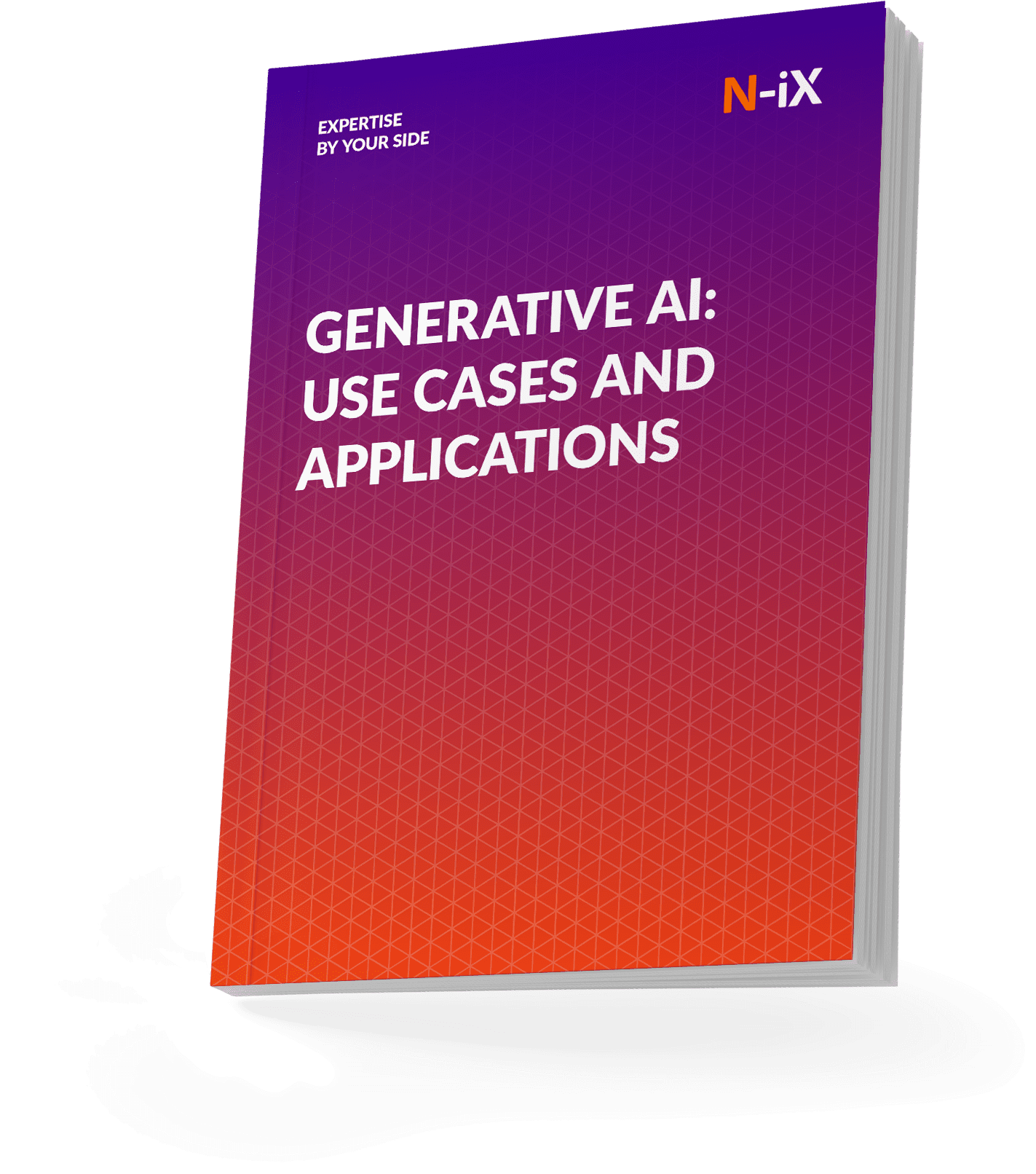Data is undeniably the new currency of the digital age. However, despite the abundance of information, 41% of business leaders find it challenging to interpret their data due to its complexity and inaccessibility.
Why is this a problem? The sheer volume and intricacy of data can result in the use of incorrect or outdated information for analysis, leading to flawed insights and decisions. But here's the solution: Generative AI for data analytics. When properly implemented, Generative AI can advance data exploration, streamline workflows, and uncover deeper, more accurate insights.
So, what can Generative AI do for data analytics? Let's delve deeper into its applications.
The role of Generative AI in data analytics
Generative AI is a recent advancement in Artificial Intelligence with significant potential. According to Statista report, its market value is expected to rise from $44.89B in 2023 to an estimated $207B by 2030. How does Generative AI achieve this? By leveraging sophisticated machine learning models, particularly neural networks, Generative AI can understand and create complex data structures. Here's a closer look at how it works:
The AI trains on vast datasets and learns to recognize data structure and individual patterns through iterative learning, gradually refining its understanding. Using the knowledge gained from training, the AI creates new outputs that align with the recognized patterns and structures, demonstrating its ability to generate original content.
To understand Generative AI better, it's essential to be aware of its fundamental principles:
- It relies on probabilistic models to generate new data. These models estimate the probability distribution of the input data and sample from this distribution to create new data points.
- Generative models improve through iterative training, continuously refining their outputs based on feedback from a discriminator (in the case of GANs) or reconstruction errors.
How to leverage Generative AI for effective data analytics

Data augmentation
Generative AI improves the performance of machine learning models, especially when dealing with limited datasets. By creating synthetic data that closely mimics the characteristics of the original data, generative AI can effectively fill in gaps and balance class distributions in training datasets. This process involves generating additional data points that follow the same statistical patterns as the real data, thereby enhancing the diversity and robustness of the dataset.
For example, Generative AI in healthcare can produce synthetic patient records to supplement small datasets. This enables more effective training of predictive models for disease diagnosis. By using synthetic data that mirrors real patient data, healthcare providers can improve the accuracy of diagnostic tools, leading to better patient outcomes.
Predictive analytics
Generative AI significantly enhances predictive analytics by simulating various scenarios and generating possible future outcomes. Traditional predictive models rely heavily on historical data to forecast future trends. However, generative AI can create hypothetical scenarios that may not be present in the historical data, providing a broader range of possibilities for analysis. This capability allows businesses to explore "what-if" scenarios and assess the potential impact of different strategies or decisions. Users can ask, "What are the top five customer preference trends for the previous quarter?" and receive a concise summary using natural language processing.
Generative AI for data analytics also uncovers additional insights and relationships within existing datasets. By analyzing patterns and correlations, generative models suggest new avenues for investigation or highlight overlooked trends, creating a proactive approach to data exploration.
For instance, Generative AI in finance can simulate market conditions and generate potential stock price movements. Financial institutions can better manage risk and develop more robust trading strategies by simulating various economic conditions and their impact on stock prices.
Scenario simulation
Scenario simulation is another powerful application. Generative AI can simulate real-world scenarios, allowing analysts to test hypotheses, improve predictions, and study potentially risky situations without needing physical data collection. Generative AI can create synthetic data representing various crisis scenarios, enabling financial institutions to stress-test their models and prepare better risk mitigation strategies.
Here's how it goes: In the automotive industry, generative AI can test autonomous vehicle responses to rare but critical driving scenarios. By simulating events such as sudden pedestrian crossings or unexpected obstacles, generative AI helps develop safer and more reliable autonomous driving systems. This ensures that vehicles can handle a wide range of potential driving situations, reducing the risk of accidents and improving overall road safety.
Data lifecycle management
Generative AI can significantly streamline data lifecycle management by improving data extraction through web scraping, schema inference, and transactional data extraction. It enhances data integration with schema mapping, entity resolution, and data unification and optimizes data transformation with data cleansing and mapping. Generative AI for data analytics also supports data discovery with profiling, clustering, visualization, anomaly detection, and conversational interfaces, making data analysis more efficient and insightful across various applications.
Let's look at it in detail: Generative AI in manufacturing can streamline the integration of production data from various sources for comprehensive analysis. This improves the efficiency of manufacturing processes and helps identify areas for optimization.
Anomaly detection
Anomaly detection is another critical area where Generative AI excels. Traditional anomaly detection methods often need help with identifying subtle and complex anomalies within large datasets. Generative models, however, can learn the normal patterns and behaviors of a dataset and identify deviations from these norms with high accuracy. Unlike traditional methods, which may rely on predefined rules or simpler statistical methods, Generative AI models can handle complex and high-dimensional data, making them more effective at spotting subtle anomalies.
For example, generative AI can monitor network traffic to detect unusual activities that may indicate a security breach. By continuously learning from the data, generative models can adapt to new types of anomalies and deploy generative AI to detect anomalies in real-time, identifying potential threats such as data exfiltration or unauthorized access.
Feature engineering
Feature engineering is a critical step in the data analytics process, involving creating new variables that can improve the performance of predictive models. Generative AI can automate this process by analyzing existing data and identifying complex patterns and relationships that may not be immediately apparent to human analysts. Generative AI for data analytics enriches the dataset and provides deeper insights into the underlying data structures by generating new features that capture these patterns.
Here's why it's useful: In finance, generative AI can create new features based on transaction histories and customer behavior, leading to more accurate credit scoring and fraud detection models. For example, a bank can use generative AI to analyze transaction data and generate features that indicate creditworthiness, such as spending patterns and repayment behaviors.
Data visualization
Generative AI for data analytics simplifies uncovering valuable insights by categorizing and segmenting data. It suggests additional questions to help users understand their data. Generative models can analyze vast amounts of data, identify key patterns and trends, and translate these insights into visually appealing charts, graphs, and other visualizations. These visualizations are tailored to different user groups' specific needs and preferences.
Generative AI in retail can develop visualizations that track inventory levels and sales performance. This helps retailers make informed decisions about stock management and sales strategies.
Data imputation
Generative AI can dynamically predict and impute missing values by understanding the underlying patterns in the dataset. This results in more complete and reliable datasets, which are essential for accurate analysis. Unlike traditional imputation methods, which may introduce biases, Generative AI provides more nuanced and contextually appropriate estimations, enhancing the validity of the analytics.
For instance, generative AI can predict missing call data records to improve customer behavior analysis and churn prediction models. This helps telecom companies better understand their customers and develop retention strategies.
Challenges of Generative AI for data analytics
Implementing Generative AI for data analytics comes with several significant challenges. Let's dive into the key issues:
Data quality and cleaning
Generative AI models thrive on vast amounts of clean, relevant data. Unfortunately, many organizations deal with data that is messy, incomplete, or not fully representative of the real-world scenarios they are analyzing. Cleaning and organizing this data is a labor-intensive process that can delay the deployment of AI solutions and lead to less reliable results if not done correctly.
Solution: N-iX offers comprehensive data management services that ensure the preparation and organization of high-quality data. Our experts utilize advanced data cleansing and preprocessing techniques to transform messy, incomplete datasets into clean, reliable data that Generative AI models can efficiently use.
Computational resources
Another major challenge is the need for substantial computational resources. Training Generative AI for data analytics, especially those involving complex architectures like Generative Adversarial Networks or Variational Autoencoders, requires powerful hardware such as high-end GPUs or TPUs. This equipment is expensive and consumes a lot of energy, making it a costly endeavor.
Solution: N-iX provides robust cloud solutions and infrastructure management to support the demanding computational needs of Generative AI models. We offer scalable, cost-effective access to high-performance computing resources such as GPUs and TPUs by leveraging cloud platforms like AWS, GCP, and Azure.
Scalability and maintenance
Additionally, scaling this infrastructure to handle increasing data and more complex models can be technically demanding and resource-intensive. The effort required to maintain and upgrade these systems can be substantial, posing a barrier to widespread adoption.
Solution: N-iX specializes in scalable architecture design and MLOps (Machine Learning Operations) practices that streamline AI model deployment, monitoring, and maintenance. Our solutions include automated workflows, continuous integration, and deployment pipelines facilitating seamless scaling and model updates.
Featured N-iX case studies on the implementation of Generative AI solutions
Cleverbridge, headquartered in Germany, provides comprehensive ecommerce and subscription management solutions. Facing challenges like reducing churn rate and maximizing Customer Lifetime Value, Cleverbridge was looking to adopt machine learning techniques to predict subscription churn and devise effective communication strategies.
N-iX guided Cleverbridge's AI adoption by designing and implementing robust machine learning systems. Leveraging MLOps, N-iX enabled 24/7 operations and built LLM-powered applications. Our engineers developed a multi-tenant machine learning solution to predict subscription churn and recommend communication strategies. This solution predicted churn and incorporated algorithms to suggest and implement tailored communication strategies. Moreover, we employed MLOps best practices to ensure a resilient machine learning system.
The Generative AI solution for content creation significantly increased the speed of producing new marketing materials. This solution, combined with advanced analytics and an extended tool selection for campaign management, enabled Cleverbridge to segment email campaigns effectively. For each segment, the algorithm adjusted campaign intensity. When users were likely to cancel subscriptions, the algorithm sent special offers, personalized content, and re-engagement emails to retain them.
Read more: Driving growth in ecommerce with a comprehensive data analytics solution
Another successful implementation of Generative AI was with a rapidly growing brokerage firm that sought to streamline routine tasks and improve employee efficiency. N-iX developed a custom internal web portal powered by Generative AI to automate tasks such as writing emails, creating JIRA tickets, and describing application features for better data analytics.
By incorporating MLOps practices and ensuring robust data security through multi-tenant data storage and advanced authentication measures, we helped the client significantly enhance operational efficiency.
Read more: Streamlining operations and boosting efficiency in finance with Generative AI
Wrapping up
Success with Generative AI hinges on having properly prepared data. Without well-structured data, your business might not fully capitalize on the benefits of this powerful technology. At N-iX, we have a proven track record of implementing Generative AI solutions for Fortune 500 companies. Our expertise is recognized by ISG as a Rising Star in data engineering
N-iX has a pool of over 2,200 experts, including 200 data experts and seven data system architects. N-iX's expertise in data preprocessing, feature engineering, and model validation ensures our clients can benefit from Generative AI to its fullest potential. By focusing on quality and scalability, we help organizations overcome the limitations of Generative AI and unlock its full value.
WHITE PAPER
Get your ultimate guide on Generative AI use cases and applications!


Success!

Have a question?
Speak to an expert




